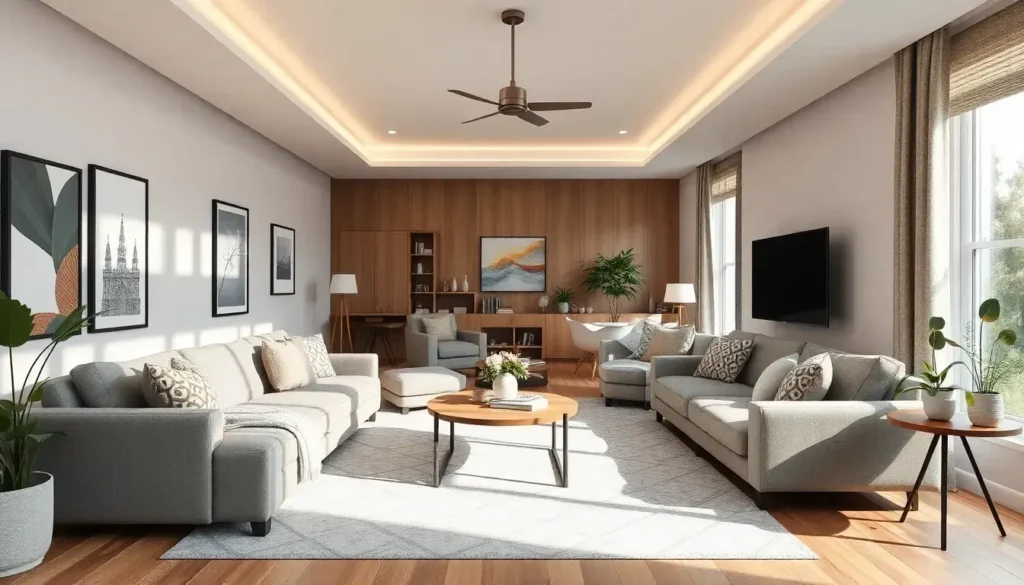Designing a long living room can feel like a puzzle, especially when you’re trying to make the most of every inch. This post comes from my own journey of figuring out how to create a space that feels open, inviting, and functional. I wanted to explore ways to breathe life into those narrow layouts that often leave you feeling boxed in. If you’ve ever found yourself staring at your long living room and wondering how to transform it into a cozy retreat, this guide is for you.
Whether you’re living in a compact apartment or a spacious home, you deserve a living room that flows naturally and feels just right. You might be searching for clever ways to rearrange furniture, light up your space with natural light, or even introduce some fresh decor ideas. In this blog post, I’ve curated over 30 design ideas specifically tailored for long living rooms. You’ll discover practical solutions that are both stylish and easy to implement.
From embracing vertical space to choosing the right rugs to create zones, each idea offers a way to enhance your living space. Get ready to dive into creative layouts that maximize your square footage while keeping comfort in mind. Plus, I’ll share tips on how to let the sunshine in and make your room feel open. By the end of this post, you’ll feel inspired and empowered to transform your long living room into a space that feels cohesive and inviting.
Get ready to explore smart furniture ideas, stylish decor tips, and all the little touches that can turn your living room into a space you love. Let’s make your long living room a place that flows effortlessly and feels like home.
Key Takeaways
– Explore over 30 design ideas that cater specifically to long living rooms, ensuring a cozy and functional layout.
– Discover how to create zones with rugs to define spaces, making your living room feel more intentional and organized.
– Learn practical ways to maximize natural light, enhancing the overall ambiance and making your room feel more spacious.
– Find space-saving furniture ideas that not only fit your room but also add style and comfort.
– Get inspired by various decor styles, from minimalist to bohemian, to personalize your living room and reflect your unique taste.
1. Open Concept Living Room Layout
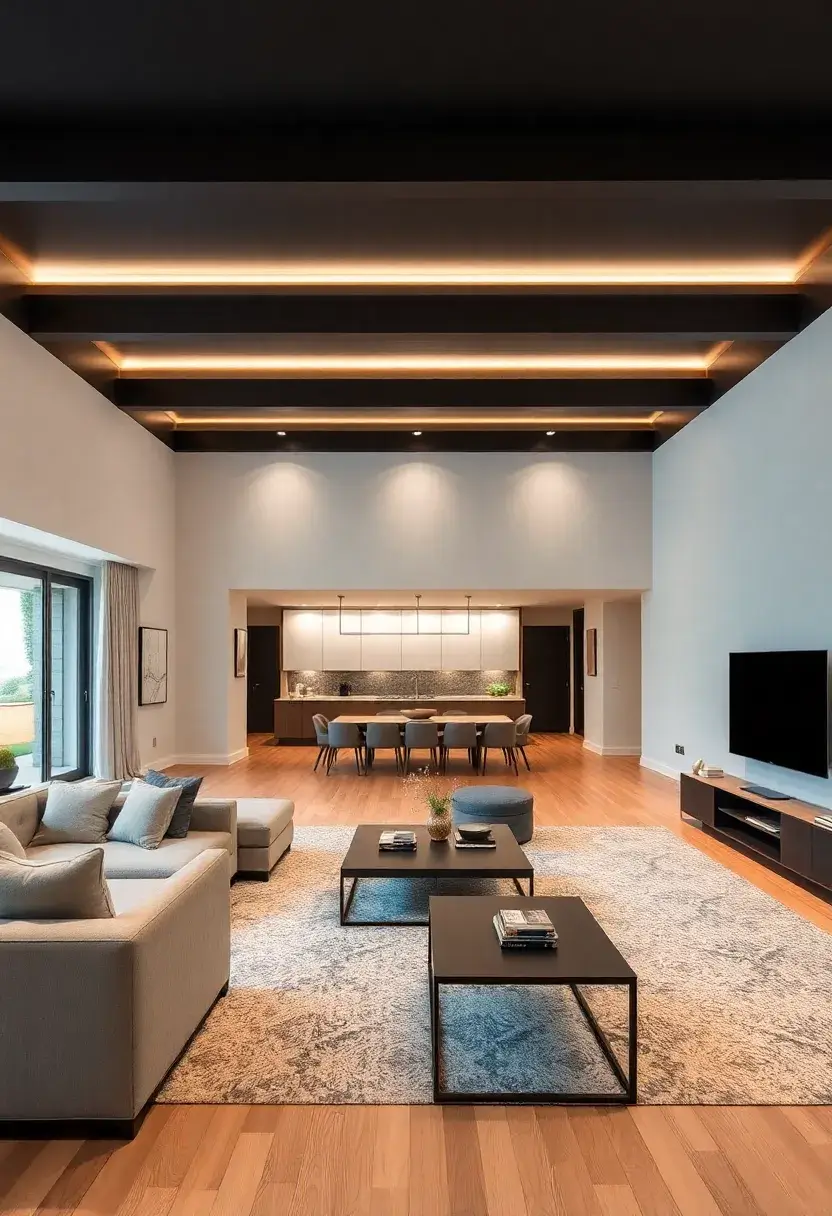
An open concept layout works wonders in long living rooms, fostering a smooth flow between areas. You can use multifunctional furniture like a stylish storage ottoman that doubles as extra seating. This kind of design feels spacious and welcoming, perfect for gathering with friends and family. Pinterest is buzzing with ideas on how to create inviting spaces using this layout, enhancing both comfort and style.
To make it practical, invest in a large area rug to visually anchor the space and separate different zones. Look for budget-friendly furniture that you can easily rearrange to suit your needs. Keep a cohesive color palette to enhance the flow, making your living room feel connected and inviting, perfect for cozy gatherings.
• Use a large area rug to define areas.
• Keep a cohesive color palette for flow.
• Choose multifunctional furniture for versatility.
• Layer lighting for warmth and ambiance.
These tips will help you create a welcoming and functional open space in your long living room.
Open Concept Living Room Layout
Editor’s Choice

SONGMICS MAZIE Collection – 43 Inches Folding Storage Ottoman Bench, Ott…
 Amazon$49.98
Amazon$49.98
AMADA HOMEFURNISHING 8×10 Washable Area Rug, Low-Profile Large Area Rug …
 Amazon$63.99
Amazon$63.99
TORCHSTAR 3 Inch 5CCT LED Pinhole Recessed Lights with J-Box, 30° Ultra-…
 Amazon$62.98
Amazon$62.982. Cozy Living Room Decor
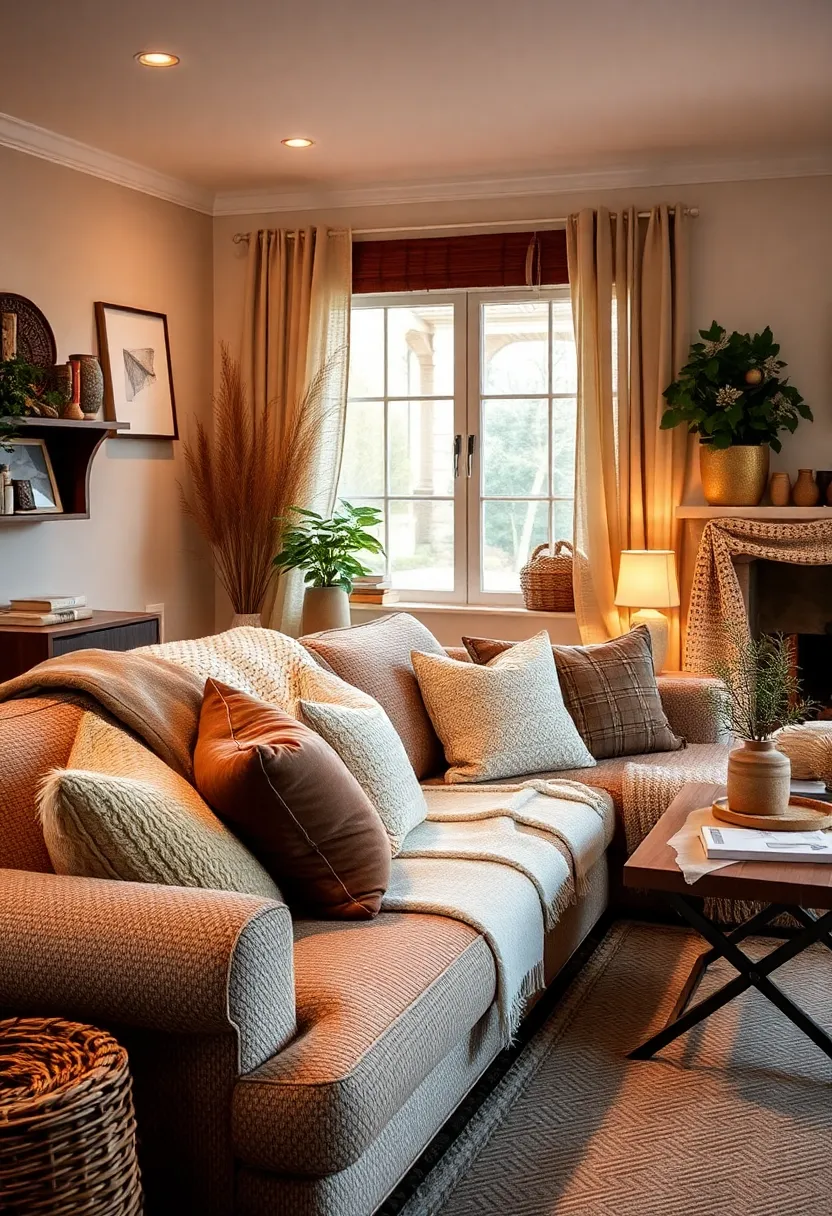
Creating a cozy feel in your long living room centers around layering textures and embracing warm colors. Start with a plush sofa adorned with fluffy throw pillows and a soft blanket. Mixing textures, like chunky knit throws or faux fur, makes the space inviting and comfortable. As seen in popular home decor magazines, warm lighting from lamps adds a soft glow, enhancing the welcoming vibe.
For practical tips, choose budget-friendly items like thrifted pillows or handmade blankets to keep costs low. Incorporating personal touches, like family photos or local artwork, makes your space feel uniquely yours. This approach creates a cozy haven, perfect for relaxing or entertaining loved ones.
• Mix and match different textures for warmth.
• Use a variety of lighting sources for ambiance.
• Add plants to bring in a touch of nature.
• Include personal items for character.
These ideas will help you create a warm and inviting long living room that feels like home.
Cozy living is built on texture and warm color, not price tags. Layer chunky knits, faux fur, and thrifted cushions, then finish with soft lighting to transform a long living room into a welcoming, lived-in retreat.
Cozy Living Room Decor
Editor’s Choice

Bigacogo Chunky Knit Throw Blanket for Couch, 40×60 inches, 100% Hand Kn…
 Amazon$37.98
Amazon$37.98
Cheer Collection Throw Pillows for Couch and Bed, Soft Shaggy Throw Pill…
 Amazon$39.99
Amazon$39.99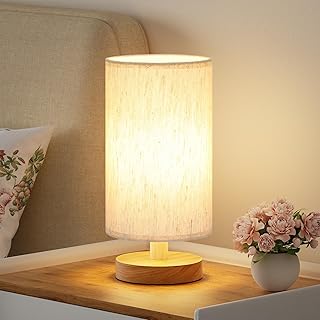
Fenmzee Small Table Lamp for Bedroom – Inline Control, Bedside Lamp with…
 Amazon$11.99
Amazon$11.993. Space-Saving Furniture Ideas

Space-saving furniture is key when designing long living rooms, helping you make the most of every square inch. Look for coffee tables with hidden storage or nesting tables that can tuck away to free up space. A wall-mounted desk can be folded down for work or crafts, then hidden away when not in use. Choosing slim-profile sofas or chairs ensures comfort while keeping the area open and airy.
For budget-friendly options, consider secondhand shops for unique finds. Look for versatile pieces that adapt to your needs, like ottomans that serve as both seating and storage. This approach allows you to create a functional space that feels spacious and organized, perfect for daily life.
• Choose a sectional sofa for extra seating.
• Use ottomans for storage and seating.
• Look for lightweight furniture to keep it airy.
• Opt for multi-purpose items to save space.
Implementing these space-saving ideas will make your long living room feel functional and inviting.
Great space-saving tips for a long living room: choose coffee tables with hidden storage, nest together slim-profile sofas, and mount a desk that folds away. With clever, versatile pieces, you can keep the flow open and still relax in comfort.
Space-Saving Furniture Ideas
Editor’s Choice

SONGMICS MAZIE Collection – 43 Inches Folding Storage Ottoman Bench, Ott…
 Amazon$49.98
Amazon$49.98
TEAMIX Wall Mounted Folding Table, Black Floating Desk for Small Spaces,…
 Amazon$39.99
Amazon$39.99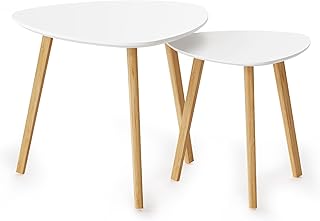
BAMEOS Bamboo Nesting Triangle End Table,Set of 2 Coffee Table Modern Mi…
 Amazon$49.99
Amazon$49.994. Maximize Natural Light

Natural light brings life to your long living room, making it feel open and inviting. Consider sheer curtains that let sunlight filter through while providing privacy. Mirrors are fantastic for reflecting light and creating depth; place them across from windows to brighten the space. Painting walls in light colors enhances this effect, amplifying the airy feel of the room.
To make it practical, choose light-colored furniture that complements your walls. Position seating to face windows, creating a welcoming atmosphere. Incorporate glass or acrylic furniture to maintain an open feel, ensuring your living room feels bright and spacious.
• Use light-colored furniture to enhance brightness.
• Position seating to face windows for warmth.
• Incorporate glass furniture for a light look.
• Use sheer curtains to maximize light.
With these simple adjustments, you can create a long living room that feels bright and airy.
Pro Tip: Embrace ideas for a long living room by flooding it with daylight—hang sheer curtains, paint in light hues, and set seating to face windows. A mirror across from windows multiplies the glow and makes the space feel wider.
Maximize Natural Light
Editor’s Choice

OWENIE Sheer Curtains 84 inches Long 2 Panels Set for Living Room/Bedroo…
 Amazon$7.93
Amazon$7.93
Namalu 6 Pcs Decorative Mirrors – Small Circle Sun Mirrors for Wall Art …
 Amazon$28.99
Amazon$28.99
3 Seater Sofa Couch with Deep Seats, 89″ Mid Century Modern Upholstered …
 Amazon$379.99
Amazon$379.995. Create Zones with Rugs

Rugs are perfect for defining zones in a long living room, adding warmth and organization. Choose large area rugs to mark spaces like a cozy reading nook or a conversation area. This not only adds comfort but visually breaks up the room, giving it structure. Layering rugs can also create depth; a larger jute rug under a smaller patterned rug adds texture and interest.
For practicality, select rugs that complement your color scheme. Ensure furniture pieces partially sit on the rug to create a cohesive look. Using different shapes can also add contrast, such as round rugs softening the long lines of the room.
• Choose rugs with complementary colors for harmony.
• Ensure furniture partially sits on the rug for cohesion.
• Use different shapes to add contrast.
• Layer rugs for added depth and texture.
These tips will help you create defined zones that enhance the comfort and style of your long living room.
Create Zones with Rugs
Editor’s Choice

AMADA HOMEFURNISHING 8×10 Washable Area Rug, Low-Profile Large Area Rug …
 Amazon$63.99
Amazon$63.99
SAFAVIEH Area Rug 4×6 – Natural Fiber Collection – Natural Brown, Handma…
 Amazon$53.78
Amazon$53.78
RoomTalks Mid Century Modern Washable Rug, Boho Cute Aesthetic 5×7 Area …
 Amazon$69.99
Amazon$69.996. Embrace Vertical Space
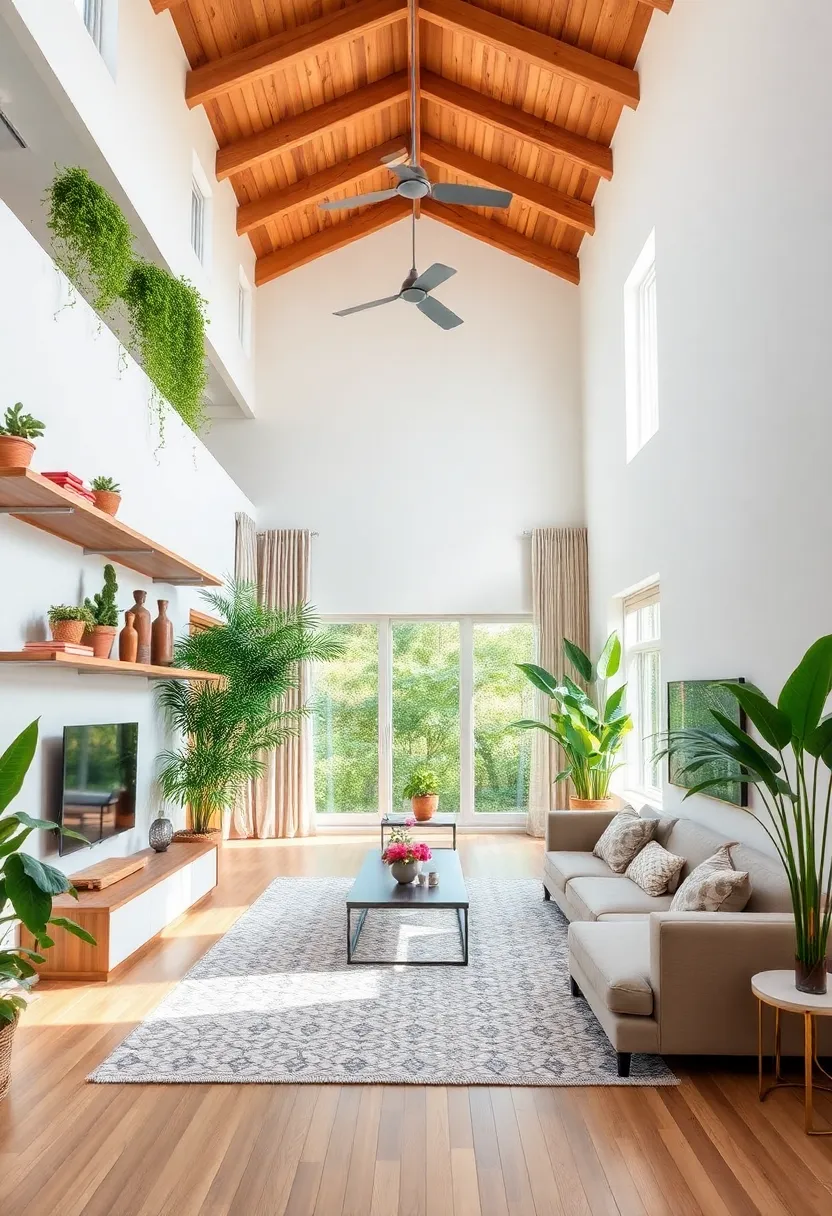
In long living rooms, utilizing vertical space can enhance the overall feel. Take advantage of tall ceilings by installing shelves that draw the eye up, creating an illusion of height. Incorporate tall plants or artwork that reaches toward the ceiling to make the room feel more expansive. Hanging pendant lights can also add drama while utilizing vertical space effectively.
For practical ideas, use wall-mounted shelves for books and decor to keep the floor clear. Hang artwork high to emphasize ceiling height, and choose tall furniture pieces that fill space without crowding. This approach brings personality and depth to your living room.
• Use wall-mounted shelves to save floor space.
• Hang artwork high to draw the eye up.
• Opt for tall furniture pieces for balance.
• Incorporate tall plants for greenery.
By embracing vertical space, you can create a long living room that feels open and inviting.
Embrace Vertical Space
Editor’s Choice

BAYKA Floating Shelves for Wall, Wall Mounted Rustic Wood Shelves for Ba…
 Amazon$20.99
Amazon$20.99
Nearly Natural 48in Dracaena Silk Plant (Real Touch) Green
 Amazon$37.00
Amazon$37.00
Modern Black Farmhouse Pendant Light with Glass Shade,Industrial Pendant…
 Amazon$19.99
Amazon$19.997. Color Coordination
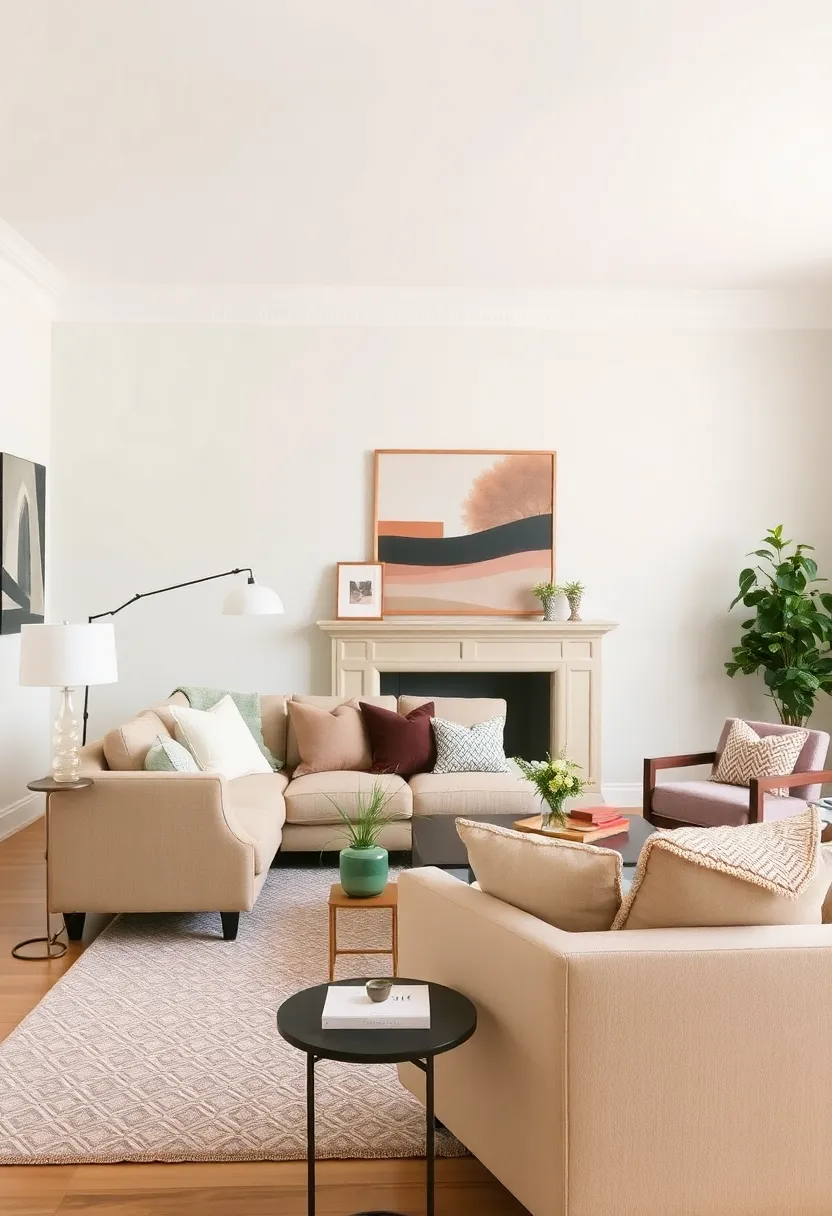
Color is vital for making a long living room feel cohesive and welcoming. Opt for a color palette that reflects your style and the mood you want to create. Soft, neutral tones can make the room feel larger, while bold colors add personality and warmth. Accent colors through cushions, artwork, or decor can tie everything together beautifully.
To implement this, use a color wheel to find complementary shades. Sticking to three main colors creates a more unified look. Experimenting with texture alongside color can add dimension without overwhelming the space, making it inviting and stylish.
• Use a color wheel for complementary colors.
• Stick to three main colors for harmony.
• Experiment with texture to add depth.
• Incorporate accent colors through decor items.
These strategies will help you create a long living room with a cohesive and inviting color scheme.
Color Coordination
Editor’s Choice

JimKing Creative Color Wheel, Paint Mixing Learning Guide, Art Class Tea…
 Amazon$4.99
Amazon$4.99
MIULEE Pack of 2 Corduroy Decorative Throw Pillow Covers 18×18 Inch Soft…
 Amazon$8.99
Amazon$8.99
VIYYIEA Vintage Gold Framed Wall Art for Living Room, Birds Canvas Print…
 Amazon$17.99
Amazon$17.998. Smart Television Placement
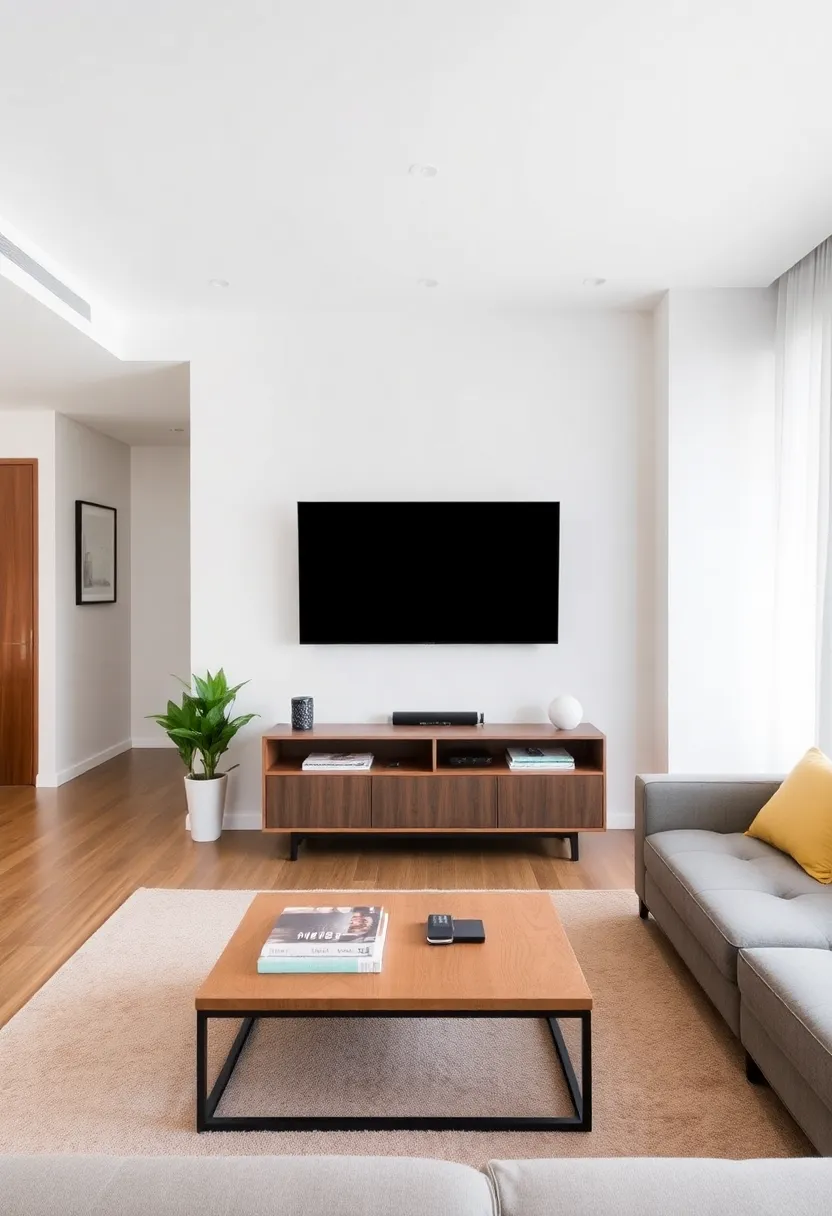
Where you place your television can affect the flow of your long living room. Consider mounting the TV on the wall to save floor space and allow for more seating arrangements. Position it at eye level from your main seating for comfortable viewing. A media console that blends with your decor can provide extra storage and display options, enhancing both function and beauty.
For practical tips, create a visual focal point by surrounding the TV with a gallery wall. Use cabinetry to conceal media devices for a cleaner look, ensuring wires are neatly managed. This keeps the space tidy and stylish.
• Create a gallery wall around the TV for focus.
• Use cabinetry to hide media devices.
• Ensure wires are neatly managed for a tidy look.
• Position the TV at eye level for comfort.
These tips will help you optimize your living room layout while keeping it stylish.
Smart Television Placement
Editor’s Choice

Mounting Dream TV Wall Mount for 32-65 Inch Television,Mount with Swivel…
 Amazon$39.97
Amazon$39.97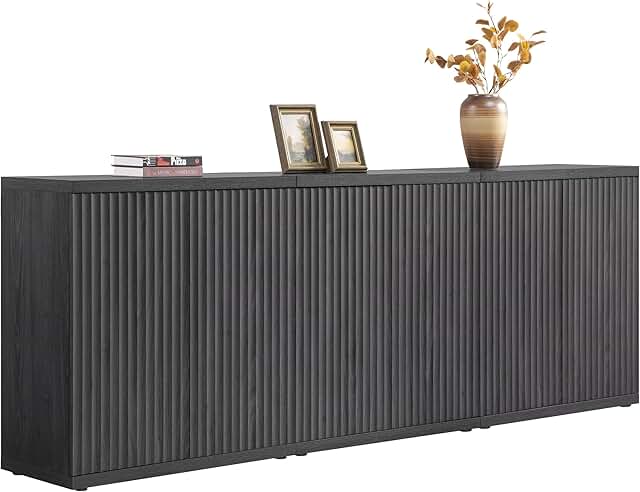
SICOTAS Buffet Cabinet with Storage Accent Sideboard Modern Credenza wit…
 Amazon$625.99
Amazon$625.99
Cord Management Organizer Kit 4 Cable Sleeve split with 41Self Adhesive …
 Amazon$15.55
Amazon$15.559. Multi-Functional Spaces
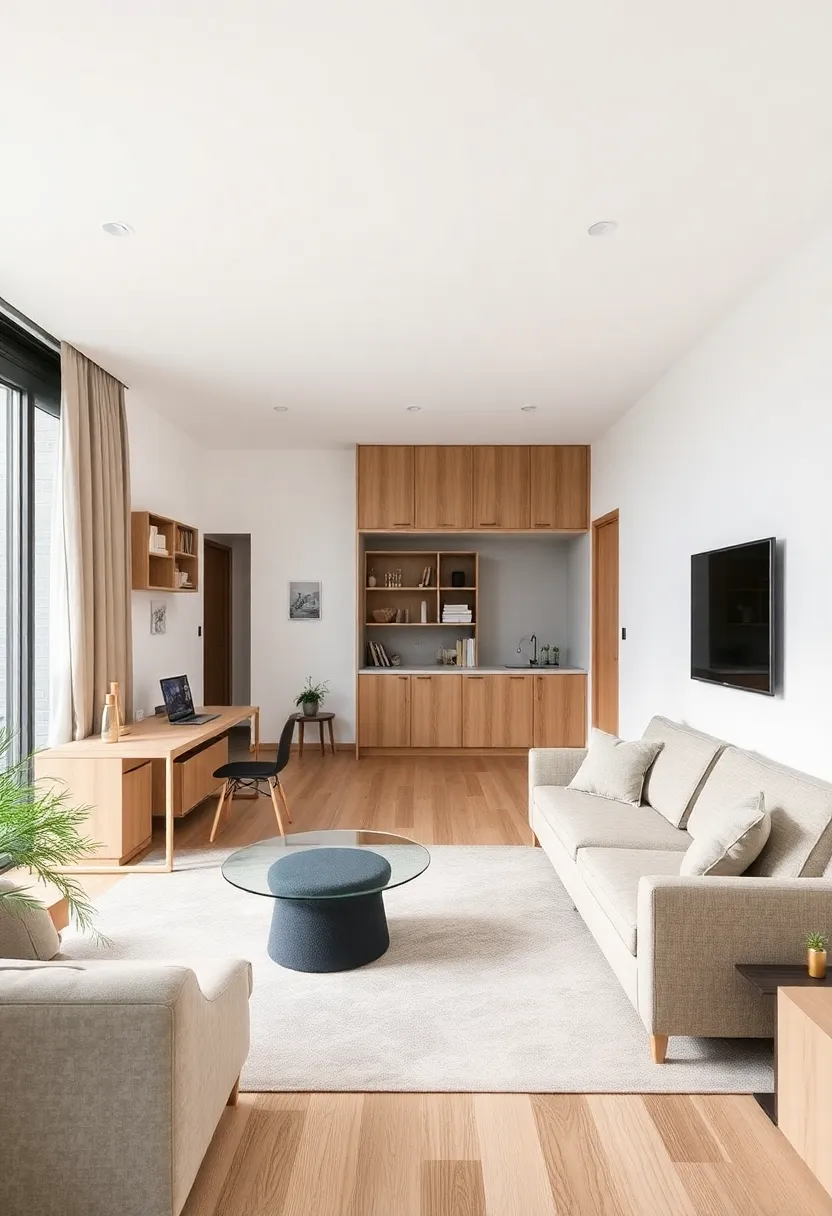
Long living rooms benefit greatly from multifunctional spaces. You can easily turn part of the room into a workspace or play area for kids, seamlessly integrating these needs without sacrificing style. Folding desks or wall-mounted workspaces can be hidden when not in use, while a colorful corner can serve as a play area with toy storage.
For practical implementation, look for modular furniture that can be reconfigured. Incorporate storage solutions that suit your dual-purpose needs, ensuring everything has a place. Use rugs or different wall colors to create visual boundaries between the areas, making it feel organized and inviting.
• Use modular furniture for flexibility.
• Incorporate smart storage solutions for organization.
• Create visual boundaries with rugs or colors.
• Ensure furniture adapts to your needs for function.
By creating multifunctional spaces, your long living room can serve various purposes while remaining stylish.
Multi-Functional Spaces
Editor’s Choice

WOHOMO Folding Desk, Small Foldable Desk 31.5″ for Small Spaces, Space S…
 Amazon$53.99
Amazon$53.99
108” Modular Sectional Sofa, Cloud Sectional Couch with Deep Seat, Moder…
 Amazon$429.98
Amazon$429.98
Lifetime Home 43″ Folding Storage Ottoman Bench for Living Room, Bedroom…
 Amazon$37.75
Amazon$37.7510. Greenery and Plants
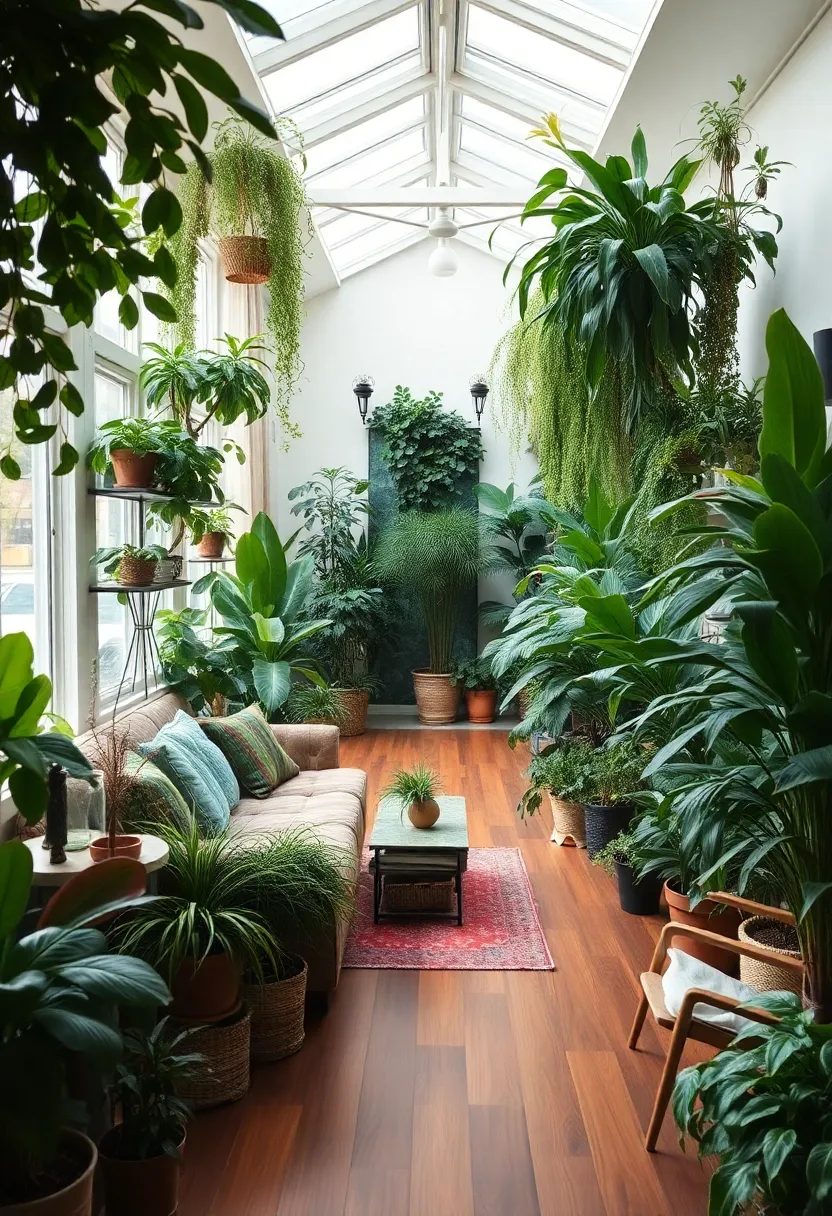
Adding greenery to your long living room enhances its appeal and liveliness. Consider using a mix of large potted plants and smaller accents on shelves or tables to create a dynamic look. Plants not only improve air quality but also bring vibrancy to the space. If floor space is limited, try vertical garden shelves or hanging planters for a creative touch.
For practical choices, opt for low-maintenance plants like succulents or snake plants that thrive in various light conditions. Using plant stands can vary heights and create visual interest. Grouping plants together can also create a lush, inviting atmosphere.
• Choose low-maintenance plants for ease.
• Use plant stands to vary heights.
• Group plants together for a lush feel.
• Incorporate hanging planters if space is tight.
These ideas will help you bring life to your long living room with vibrant greenery.
Greenery and Plants
Editor’s Choice

Outsidepride Mix Cactus Seeds – 1000 Pcs Perennial, Drought-Tolerant & L…
 Amazon$7.49
Amazon$7.49
5-Pack Decent Metal Plant Stands, Heavy Duty Flower Pot Stands for Multi…
 Amazon$19.99
Amazon$19.99
Set of 2-10 Inch Hanging Planters for Indoor Plants with Self-Watering I…
 Amazon$24.99
Amazon$24.9911. Textured Wall Treatments

Adding texture to your walls can dramatically change the vibe of a long living room. Consider options like shiplap, wallpaper, or painted accent walls to introduce depth and interest. Textured materials like brick or stone can create stunning focal points that draw the eye. Combining different textures sets a cozy and inviting tone while maintaining sophistication.
For practical ideas, consider using a gallery wall to showcase various textures and styles. Removable wallpaper allows for commitment-free decor changes, while a bold paint color can break the monotony. Textured accents can give your room a unique personality.
• Use a gallery wall to showcase texture.
• Consider removable wallpaper for flexibility.
• Paint one wall a bold color for contrast.
• Incorporate textured materials for depth.
These tips will help you create a long living room filled with character and warmth.
Textured Wall Treatments
Editor’s Choice

Art3d Smoothing Tool Kit for Applying Peel and Stick Wallpaper, Vinyl Ba…
 Amazon$5.99
Amazon$5.99
eletecpro 12×12 Picture Frames Set of 9 with Mat for 8×8 Photos or witho…
 Amazon$33.08
Amazon$33.08
Rust-Oleum 1990502 Painter’s Touch Latex Paint, Quart, Flat White 32 Fl …
 Amazon$16.98
Amazon$16.9812. Optimal Lighting Solutions

Lighting plays a crucial role in a long living room, affecting both function and atmosphere. Incorporating a mix of overhead lights, wall sconces, and table lamps creates warmth while illuminating the space effectively. Dimmers can allow you to adjust brightness, setting the mood for any occasion. Task lighting near seating areas provides ample reading light, while accent lighting highlights decor or architectural features.
For practical tips, layer different light sources to create depth and interest. Choose lamps that complement your decor style, ensuring they blend seamlessly. Strategically placing lighting will enhance the room’s inviting feel.
• Layer different light sources for depth.
• Choose lamps that match your decor style.
• Ensure lighting is strategically placed for effect.
• Use dimmers for adjustable brightness.
By optimizing your lighting, you can create a long living room that feels warm and inviting.
Optimal Lighting Solutions
Editor’s Choice

Floor lamp, 15w/1000lm Bright LED Floor Lamp with Stepless Adjustable 30…
 Amazon$29.99
Amazon$29.99
FOLKSMATE Modern LED Wall Sconces, 3000K Warm White Hardwired Wall Light…
 Amazon$39.99
Amazon$39.99
BOBOMOMO Tradition 20.5″ Rustic Table Lamp Set of 2 for Living Room Farm…
 Amazon$29.99
Amazon$29.9913. Artistic Features

Incorporating art into your long living room adds personality and flair. A gallery wall with a mix of frames and art styles can serve as a stunning visual centerpiece. Large-scale art pieces make bold statements, enhancing the overall flow of the room. Consider adding sculptures or three-dimensional art for depth and intrigue, making the space feel more dynamic.
To make it practical, choose art that includes colors from your palette to tie elements together. Changing out artwork seasonally can keep the space feeling fresh and exciting. Incorporate art at different heights for added interest and a curated look.
• Change out artwork seasonally for freshness.
• Frame personal photography for a unique touch.
• Include art at different heights for variety.
• Mix styles for a personal touch.
These ideas will help you create a long living room that reflects your personality through art.
Artistic Features
Editor’s Choice

eletecpro 12×12 Picture Frames Set of 9 with Mat for 8×8 Photos or witho…
 Amazon$33.08
Amazon$33.08
White and Blue Abstract Canvas Wall Art for Bathroom Living Room Bedroom…
 Amazon$29.99
Amazon$29.99
Sandstone Resin Thinker Style Abstract Sculpture Statue Collectible Figu…
 Amazon$7.66
Amazon$7.6614. Incorporating Technology
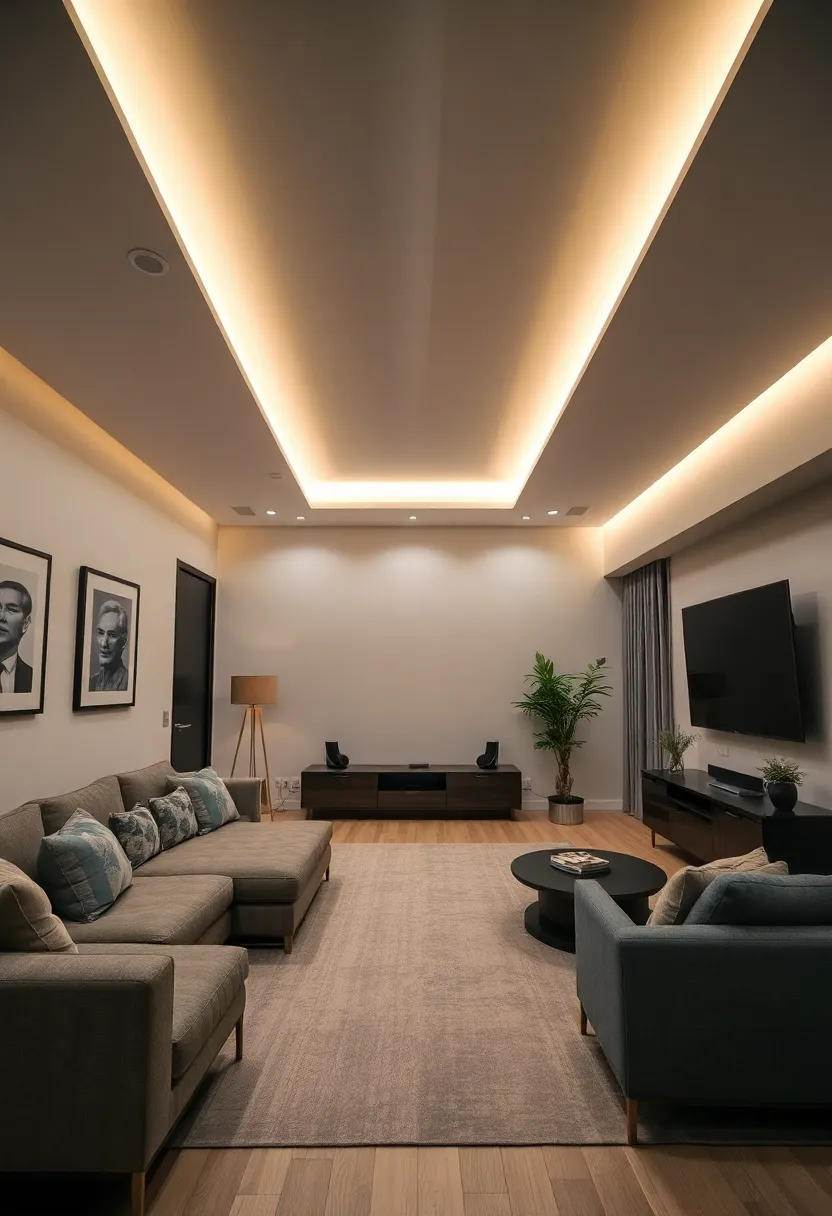
Modern living rooms often blend technology seamlessly, enhancing functionality without disrupting decor. Consider smart lighting systems that can be customized for various moods. Sound systems can be integrated into furniture pieces to provide entertainment while maintaining aesthetics. Efficient cable management ensures a clean look, keeping the space organized and stylish.
For practical tips, use smart plugs for easy device management, allowing you to control everything from your phone. Wireless speakers help free up floor space, making the area feel less cluttered. Opt for furniture with built-in charging ports to keep devices handy and the look streamlined.
• Use smart plugs for easy control.
• Choose wireless speakers to save space.
• Opt for furniture with charging ports.
• Keep cables managed neatly for a tidy look.
By thoughtfully incorporating technology, you can create a long living room that feels modern and functional.
Incorporating Technology
Editor’s Choice

EIGHTREE Smart Plug, Smart Home WiFi Outlet Works with Alexa & Google Ho…
 Amazon$20.99
Amazon$20.99
Anker Soundcore 2 Portable Bluetooth Speaker with Stereo Sound, Bluetoot…
 Amazon$27.99
Amazon$27.99
WorthFurni Sofas for Living Room, Chenille Loveseat Couch Set, Small Sof…
 Amazon$298.99
Amazon$298.9915. Personal Touches and Accessories

To make your long living room truly feel like home, personal touches are key. This could include family heirlooms, travel mementos, or handmade decor pieces that tell your story. Mixing these personal items with curated decor creates a space that reflects your unique style. Consider using books and unique knick-knacks as decor elements on shelves or tables, bridging functionality with aesthetics.
For practical ideas, create a memory wall with photos and souvenirs, showcasing moments that matter to you. Use open shelving to display meaningful items, while rotating accessories seasonally keeps it fresh. This personal touch makes your space inviting and warm.
• Create a memory wall with photos.
• Use open shelving to display keepsakes.
• Rotate accessories seasonally for variety.
• Include unique items to tell your story.
These ideas will help you create a long living room that feels personal and inviting.
Personal Touches and Accessories
Editor’s Choice

BAYKA Floating Shelves for Wall, Wall Mounted Rustic Wood Shelves for Ba…
 Amazon$20.99
Amazon$20.99
upsimples 10 Pack Picture Frames Collage Wall Decor for Mounting or Tabl…
 Amazon$21.59
Amazon$21.59
3 Link Wood Knot Decor – Hand Carved Coffee Table Decoration, Boho Chain…
 Amazon$14.99
Amazon$14.9916. Playful Patterns
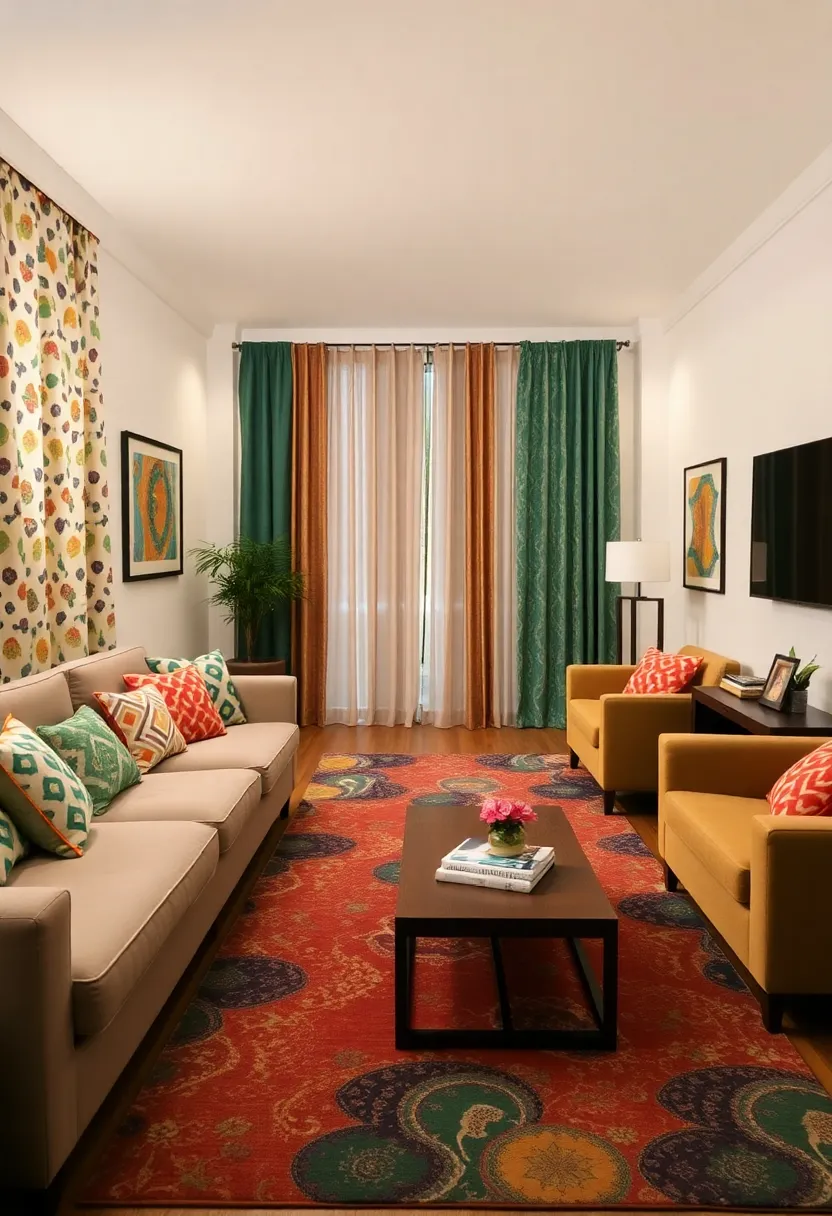
Patterns can add a lively dimension to a long living room. Incorporate patterned throw pillows, rugs, or curtains to inject personality into the space without overwhelming it. Mixing patterns can work beautifully if they share a common color scheme or theme. Using patterned accessories creates focal points without altering larger furniture pieces, keeping the look cohesive and balanced.
For practical tips, opt for bold patterns on smaller items if you’re hesitant to go big. Monochromatic patterns can keep things sophisticated while adding interest. Experimenting with scale—large patterns for statements and smaller ones for subtlety—can also create a dynamic look.
• Opt for bold patterns on smaller items.
• Use monochromatic patterns for sophistication.
• Experiment with scale for variety.
• Mix patterns that share a common color.
These playful ideas will help you create a long living room that feels fun and inviting.
Playful Patterns
Editor’s Choice

YIcabinet Pillow Covers Set of 2, Embroidered Branch Pattern Throw Pillo…
 Amazon$25.98
Amazon$25.98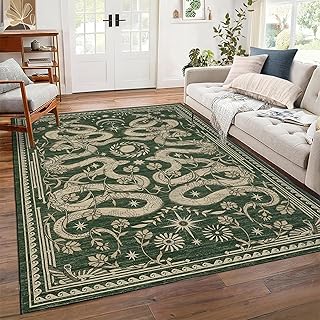
Snake Washable Rugs 5×7 Area Rug for Living Room Forest Soft Low-Pile St…
 Amazon$43.99
Amazon$43.99
Lush Decor Mid Century Geo Light Filtering Window Curtain Panel Pair, 52…
 Amazon$32.49
Amazon$32.4917. Minimalist Approach

A minimalist approach can work wonders in a long living room, highlighting simplicity and functionality. Choose essential pieces that serve multiple purposes to avoid clutter and promote a calm environment. Neutral color palettes and streamlined furniture create a spacious feel, allowing the room to breathe. Only include decor that resonates with you, making the space personal yet uncluttered.
For practical tips, use sleek lines in furniture design for a modern look. Limit the number of decor items to a few meaningful pieces that tell your story. Consider storage solutions that blend into the decor, keeping everything tidy and organized.
• Use sleek lines for a modern feel.
• Limit decor items to meaningful pieces.
• Choose hidden storage for tidiness.
• Opt for neutral colors to create calmness.
By embracing minimalism, you can create a long living room that feels open and serene.
Minimalist Approach
Editor’s Choice

Rolanstar Coffee Table Lift Top, Multi-Function Convertible Coffee Table…
 Amazon$209.99
Amazon$209.99
6×9 Beige Washable Neutral Area Rug Living Room Floral Non Slip Low Pile…
 Amazon$89.99
Amazon$89.99
Round Set of 2 Ottoman with Storage-Upholstered Velvet Vanity Stool for …
 Amazon$69.99
Amazon$69.9918. Layered Lighting
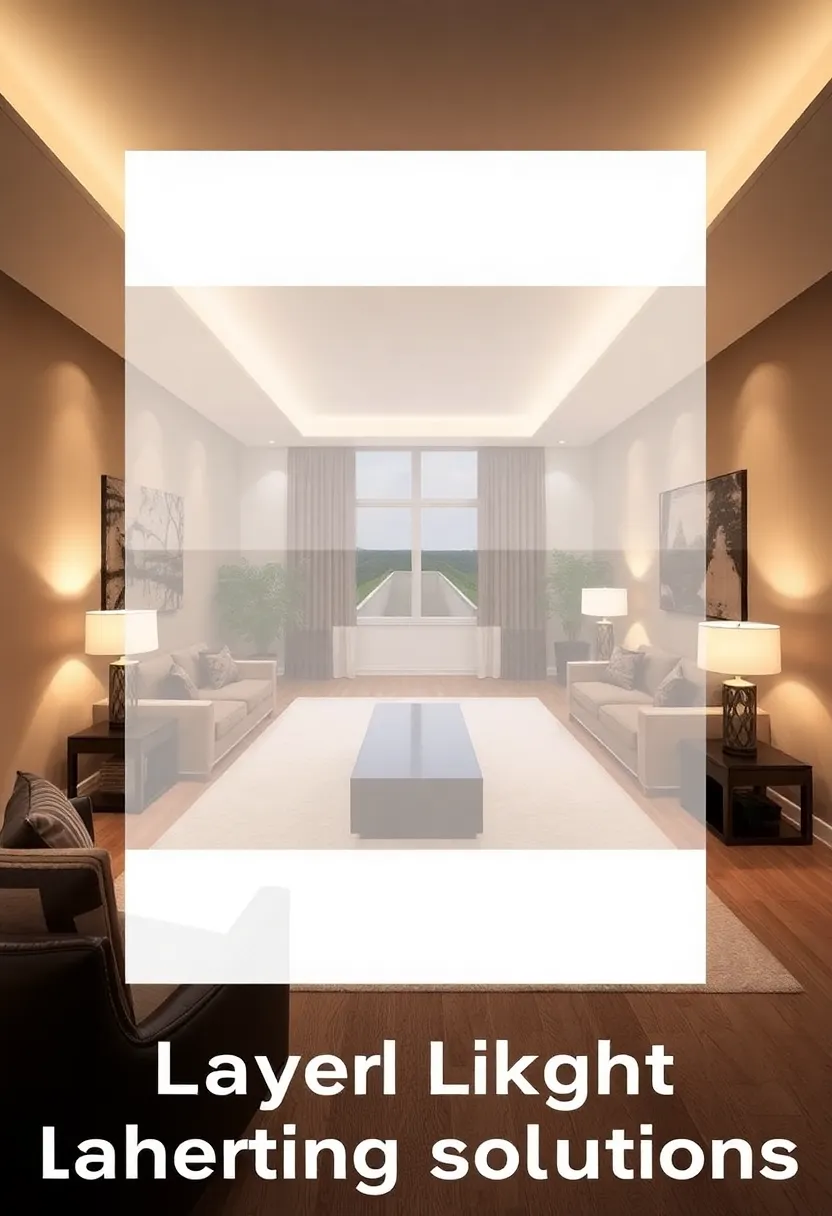
Layering lighting creates a dynamic and inviting atmosphere in a long living room. Incorporate ambient lighting for overall illumination, task lighting for specific needs, and accent lighting to highlight decor or architectural features. This mix ensures every corner feels warm and welcoming. Dimmer switches can add flexibility, allowing you to adjust brightness based on the occasion.
For practical tips, use different light sources at various heights to create depth and interest. A statement light fixture can draw attention while serving as a focal point. Employ warm bulbs for a cozy ambiance, perfect for relaxing evenings.
• Use differing light sources for depth.
• Consider a statement light fixture for style.
• Use warm bulbs for a cozy glow.
• Layer various lighting types for warmth.
These layered lighting strategies will help your long living room feel inviting and warm.
Layered Lighting
Editor’s Choice

Floor Lamp, Adjustable Height Floor Lamps for Living Room Bedroom, 120 L…
 Amazon$28.48
Amazon$28.48
TJOY 6 Pack A19 LED Light Bulbs, 60 Watt Equivalent LED Bulb, Soft Warm …
 Amazon$11.99
Amazon$11.99
Vintage Pendant Light Fixtures: Glass Pendant Lights Kitchen Island, Gre…
 Amazon$39.99
Amazon$39.9919. Rustic Charm
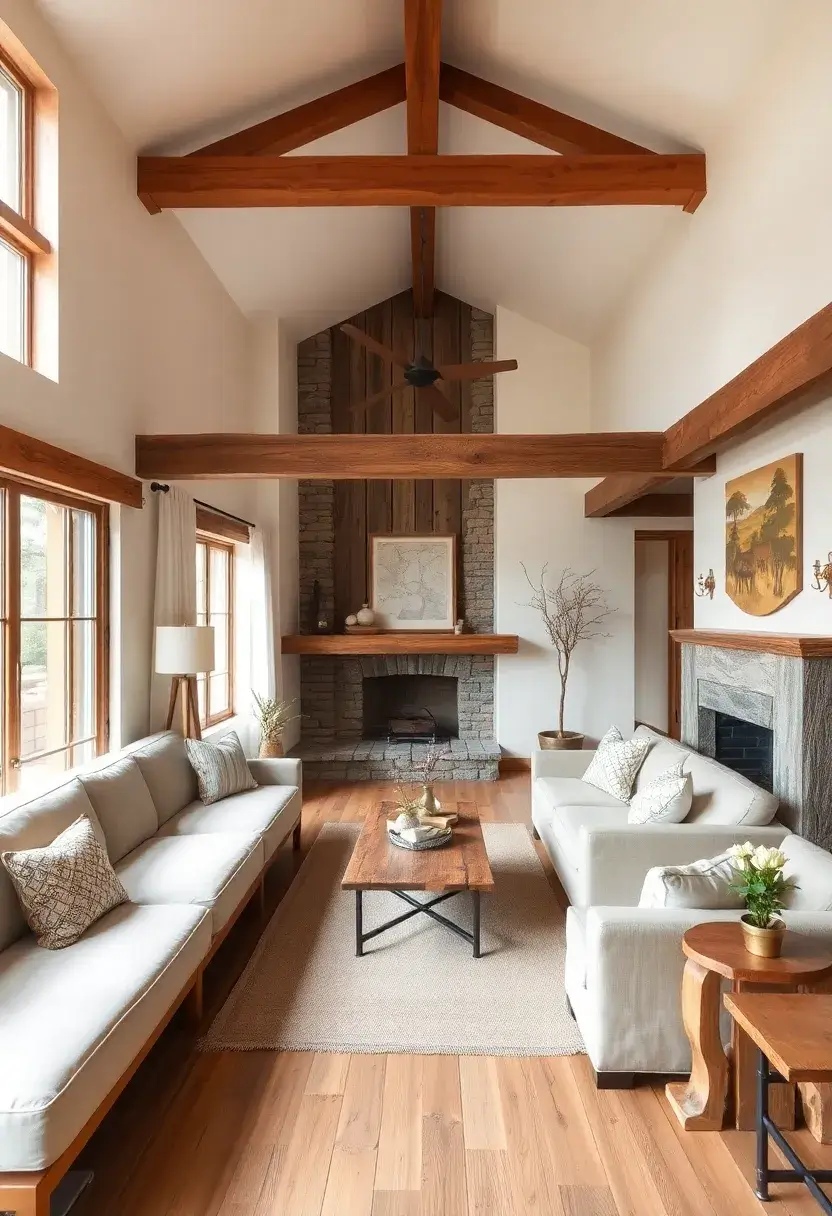
Adding rustic elements can bring warmth and charm to your long living room. Wood accents, beamed ceilings, and natural materials create an inviting atmosphere reminiscent of cozy cabins. Consider using reclaimed wood furniture for a sustainable touch that tells a story. Earthy tones and textiles like wool or burlap add to the homey vibe, making the space feel comfortable.
For practical ideas, mix rustic elements with modern fixtures for contrast. Vintage finds can add character, while oversized furniture provides comfort. This combination creates a space that feels both stylish and welcoming.
• Combine rustic elements with modern decor.
• Use vintage finds for unique character.
• Choose oversized furniture for comfort.
• Incorporate natural materials for warmth.
These rustic charm ideas will help your long living room feel cozy and inviting.
Rustic Charm
Editor’s Choice

Alaterre Furniture Pomona Coffee Table with Storage Shelf-Industrial Mod…
 Amazon$229.95
Amazon$229.95
56″W Oversized Chaise Lounge Chair Indoor,Plush Faux Fur Sleeper Sofa Co…
 Amazon$309.99
Amazon$309.99
Burlap Throw Blanket, Lightweight Soft Fleece Blanket for Couch Bed 40″x30″
 Amazon$21.99
Amazon$21.9920. Bohemian Vibes
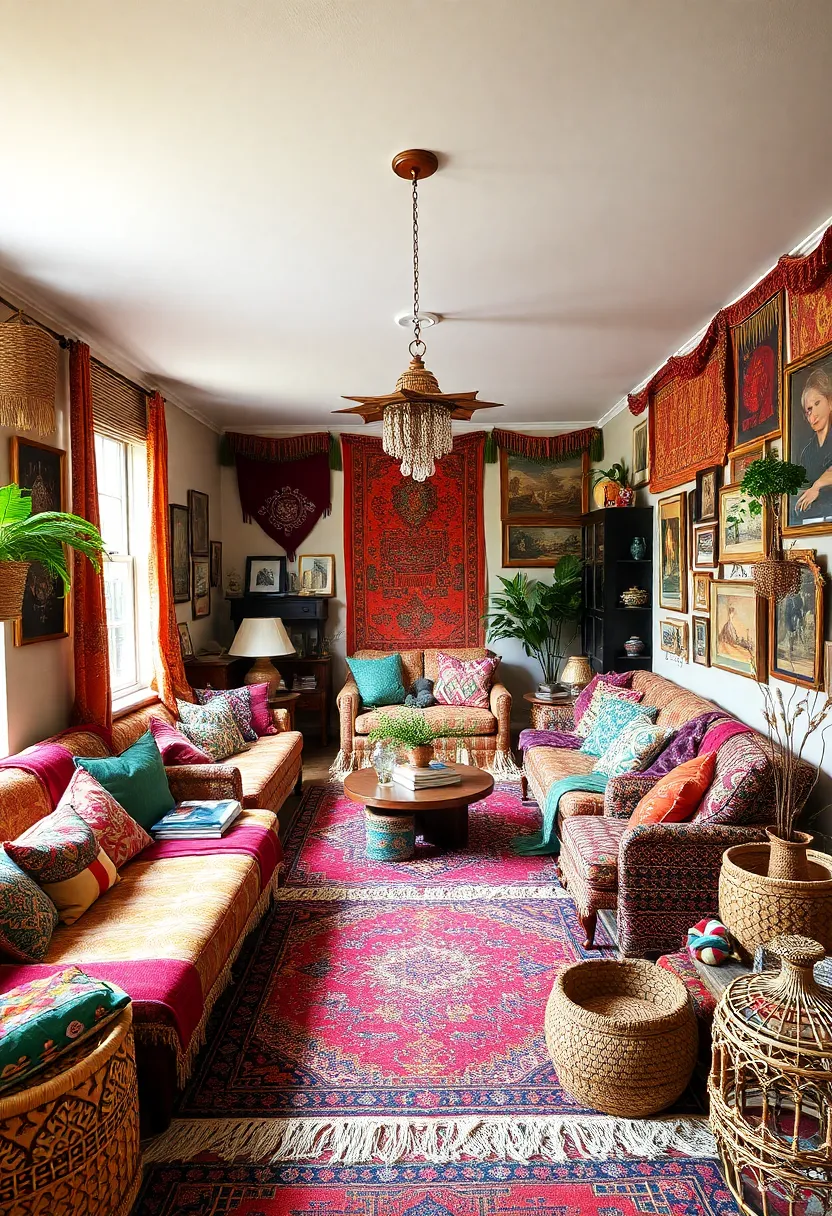
Embracing a bohemian style allows for creativity and individuality in your long living room. Layering different textiles, patterns, and colors creates a warm, inviting atmosphere. Incorporate a variety of throw pillows, blankets, and rugs for that eclectic look, not shying away from mixing patterns. Plants and art pieces add to the boho vibe, allowing for a personal expression of style.
For practical tips, use a variety of textures and shapes to create interest. Choose globally-inspired decor that reflects authenticity. Creating cozy nooks with oversized cushions can enhance the inviting feel, making the room perfect for relaxation.
• Use a variety of textures and shapes.
• Choose global-inspired decor for authenticity.
• Create cozy nooks with cushions.
• Mix patterns for an eclectic vibe.
These bohemian ideas will help you create a long living room that’s full of character and warmth.
Bohemian Vibes
Editor’s Choice

Boho Throw Pillow Covers 18×18 inch Set of 2,Bohemian Vintage Carpet Pat…
 Amazon$11.99
Amazon$11.99
SHACOS Soft Cozy Fluffy Arch Pattern High-Low Pile Textured Area Rug 5’3…
 Amazon$69.99
Amazon$69.99
Costa Farms Live Plants (3 Pack), Easy to Grow Real Indoor Houseplants, …
 Amazon$31.13
Amazon$31.1321. Coastal Inspirations
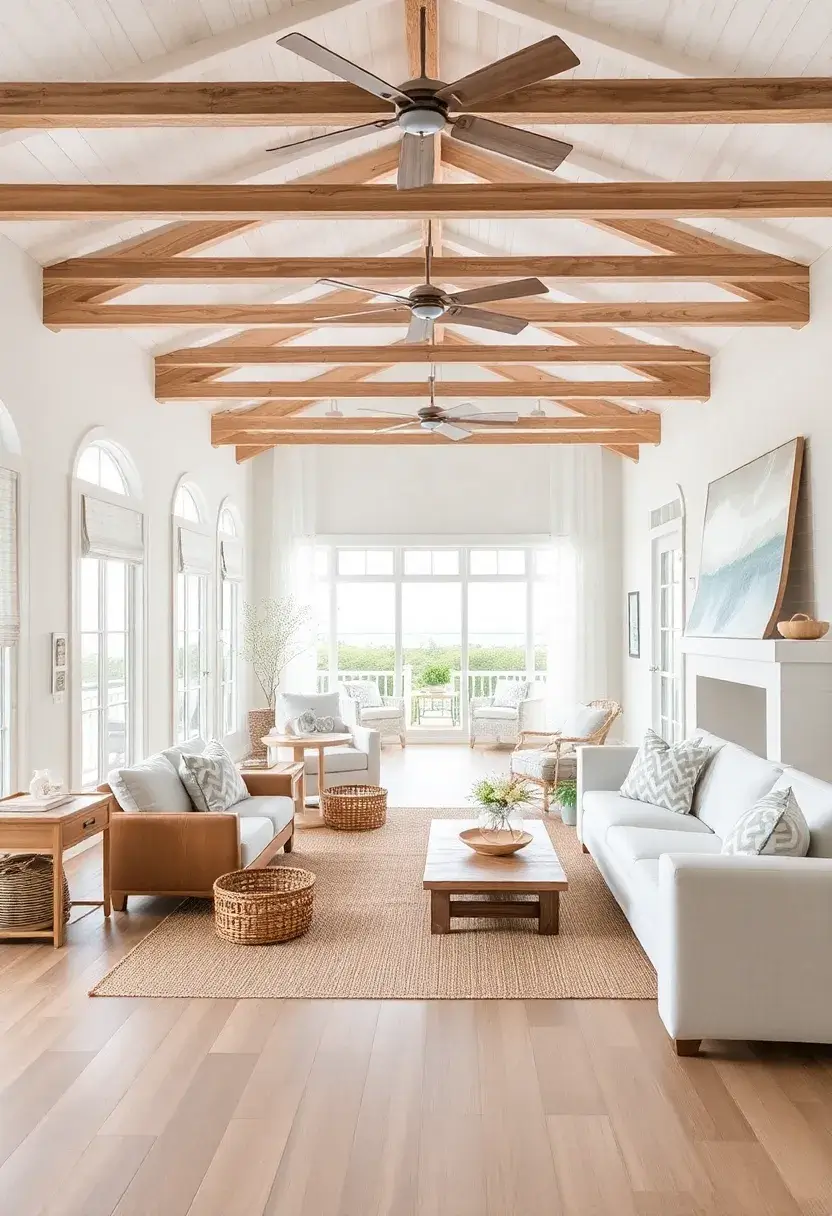
Incorporating coastal elements brings a fresh and airy feel to your long living room. Use color schemes inspired by the beach, like soft blues, sandy beiges, and crisp whites to evoke a serene atmosphere. Natural materials, such as driftwood or rattan, enhance authenticity and warmth. Lightweight fabrics for curtains and cushions can enhance the breezy vibe, making the room feel open and inviting.
For practical tips, use nautical decor sparingly to avoid theme overload. Including natural textures ensures a beachy feel without going overboard. Create a statement with seashell or coral accents for a touch of charm.
• Use nautical decor sparingly for balance.
• Include natural textures for authenticity.
• Create a statement with seashell accents.
• Opt for light fabrics for a breezy feel.
These coastal inspirations will help your long living room feel fresh and inviting.
Coastal Inspirations
Editor’s Choice

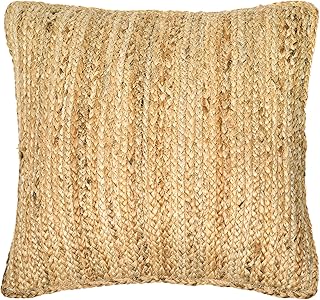
The Fine Living Co. Jute Throw Pillow Covers, Braided Decorative Pillow …
 Amazon$21.99
Amazon$21.99
OWENIE Sheer Curtains 84 inches Long 2 Panels Set for Living Room/Bedroo…
 Amazon$7.93
Amazon$7.9322. Formal Elegance

For a more formal look, integrating elegance into a long living room can be achieved through classic design elements. Heavy drapes, ornate furniture, and rich colors create a sophisticated atmosphere. A grand chandelier serves as a statement piece while enhancing the room’s elegance. Accent details like gilded mirrors and plush fabrics add to the overall polished look.
To implement this style, balance formal pieces with comfortable seating for a welcoming feel. Use a cohesive color palette to maintain sophistication throughout the space. Consider fine fabrics for an elegant touch that ties the look together.
• Balance formal pieces with comfort.
• Use a cohesive color palette for elegance.
• Choose fine fabrics for added sophistication.
• Incorporate statement lighting for drama.
These tips will help you create a long living room that exudes formal elegance.
Formal Elegance
Editor’s Choice
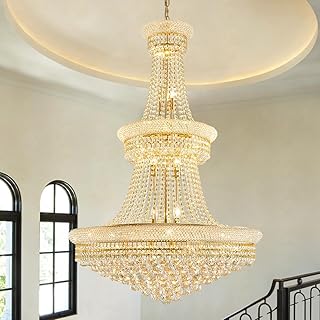
19-Lights High Ceiling Chandelier Modern Gold Crystal Chandeliers Large …
 Amazon$939.00
Amazon$939.00
NICETOWN Grey Full Shade Curtain Panels, Pair of Energy Smart & Noise Bl…
 Amazon$28.89
Amazon$28.89
Funerom Vintage 11 x 9.5 inch Decorative Mirror, Wall Mounted & Tabletop…
 Amazon$24.99
Amazon$24.9923. Eclectic Collections
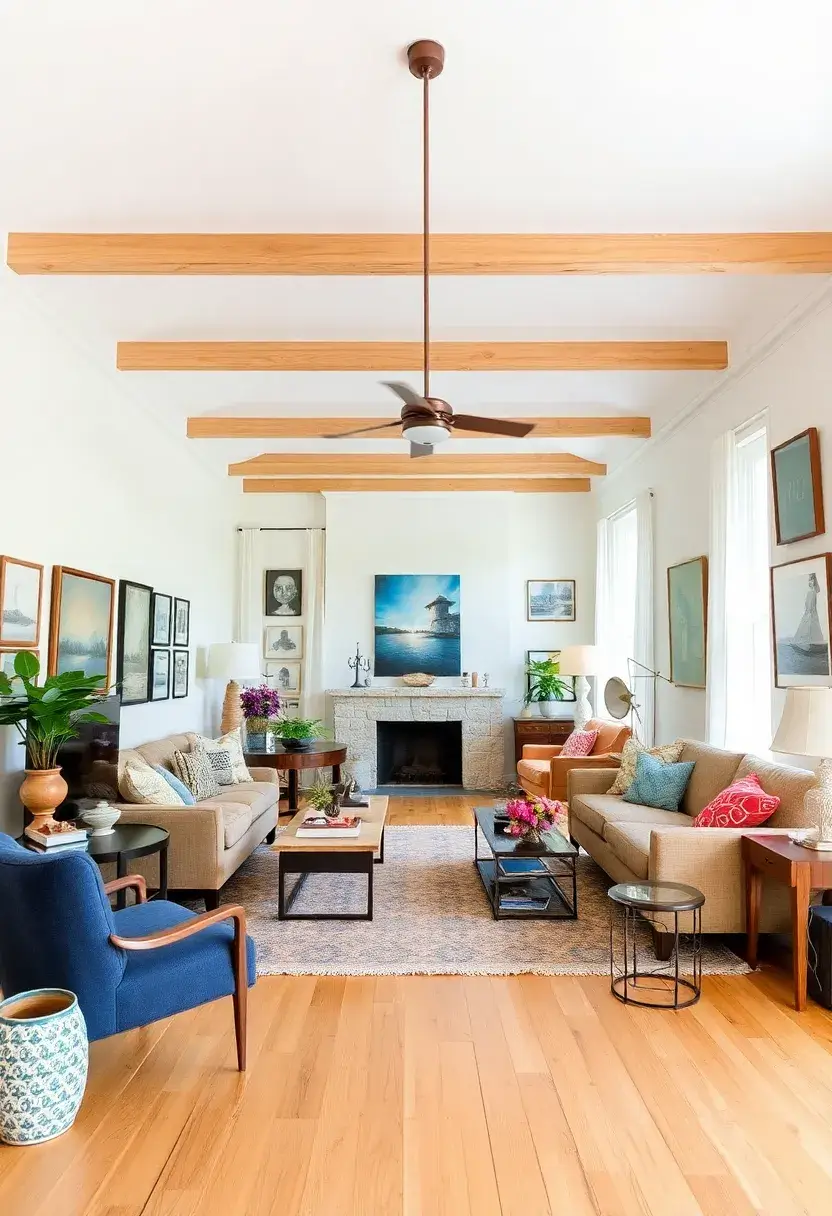
Showcasing an eclectic collection of decor can add personality to your long living room. Mixing different styles, eras, and textures creates a unique visual experience that reflects your taste. Use open shelving or display cabinets to highlight cherished items, ensuring they are arranged thoughtfully. Selecting pieces that resonate with your personal journey makes the space feel authentic and inviting.
For practical tips, avoid overcrowding; curate your collections for focus. A color scheme can tie disparate pieces together, making the display feel cohesive. Incorporate different heights to add visual interest and depth to the arrangement.
• Avoid overcrowding for focus.
• Use a color scheme to tie items together.
• Incorporate different heights for interest.
• Display curated collections for personality.
These eclectic collection ideas will help you create a long living room that’s uniquely yours.
Eclectic Collections
Editor’s Choice

REGILLER 6 Wire Shelving Steel Storage Rack Adjustable Unit Shelves for …
 Amazon$36.99
Amazon$36.99
Display Cabinet with Glass Doors, 4-Tier Curio Cabinet with 3 Color Ligh…
 Amazon$199.99
Amazon$199.99
Bloomingville Decorative Abstract Marble Sculptures, Set of 2 Styles, White
 Amazon$25.21
Amazon$25.2124. Vintage Finds
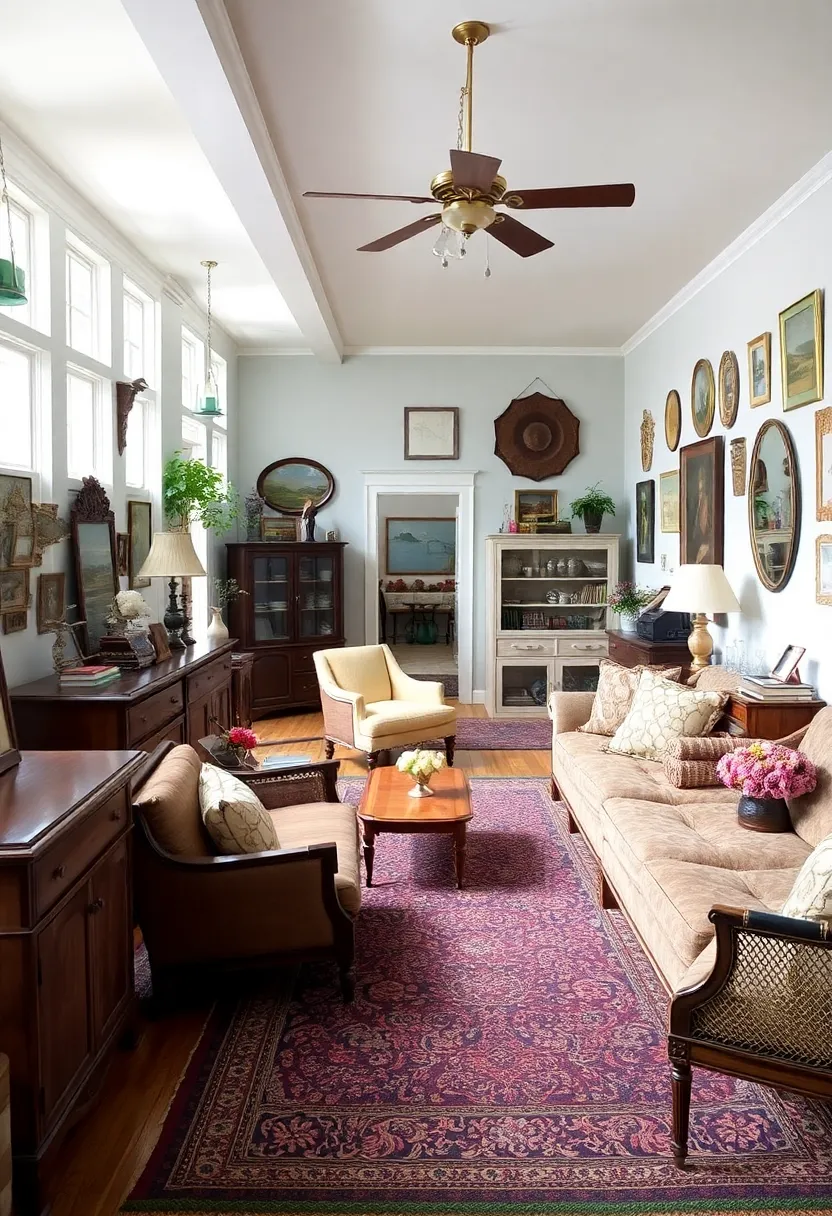
Integrating vintage finds into your long living room adds charm and history to your space. Look for thrifted furniture or decor pieces that reflect your personal style, giving a nod to the past. Mixing vintage with modern elements creates a balanced, timeless look that feels inviting. Displaying vintage items prominently allows them to serve as conversation starters, adding character to your decor.
For practical ideas, seek out unique pieces that tell a story, whether it’s a vintage armchair or an antique clock. Don’t hesitate to repurpose vintage finds for new uses, making them functional and stylish. Pairing vintage decor with contemporary designs offers a fresh aesthetic that feels welcoming.
• Look for unique vintage pieces for character.
• Repurpose vintage finds for functionality.
• Pair vintage with modern designs for balance.
• Display prominent vintage items for conversation.
These vintage-inspired ideas will help you create a long living room filled with charm and history.
Vintage Finds
Editor’s Choice

Yaheetech PU Leather Accent Chair, Mid-Century Modern Armchair with Soli…
 Amazon$89.99
Amazon$89.99
Peakeep Retro 4.5 inches Battery Operated Twin Bell Loud Alarm Clock (Bl…
 Amazon$14.99
Amazon$14.99
Dosmix Retro Bluetooth Speaker, Vintage Decor, Mini Wireless Bluetooth S…
 Amazon$13.99
Amazon$13.9925. Seasonal Decor
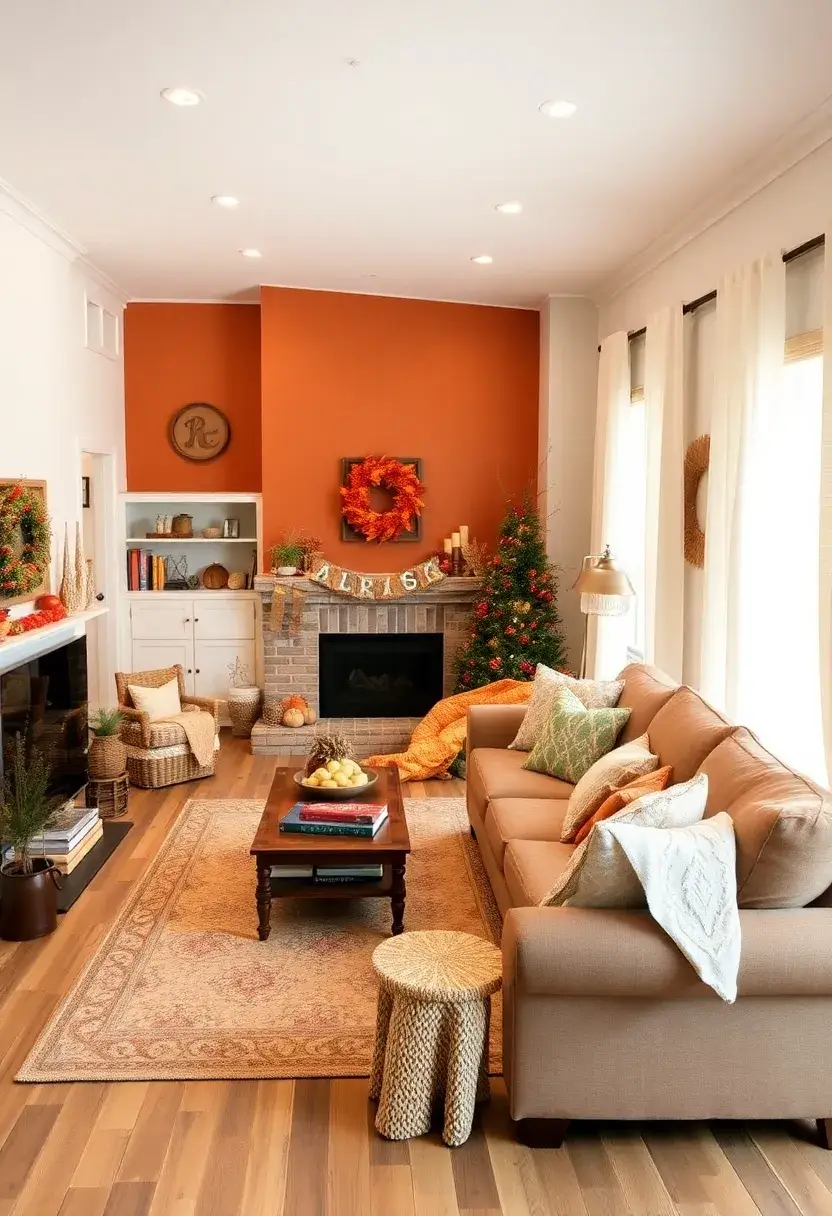
Changing your decor with the seasons keeps your long living room feeling fresh and inviting. Incorporate seasonal colors and themes through pillows, throws, and decor elements. For instance, warm tones in autumn or bright colors in summer can reflect the spirit of the season. This approach enhances the atmosphere and allows for creativity in your design.
To make it practical, use seasonal flowers or plants for a fresh look that changes throughout the year. Rotating decor items maintains variety and keeps things interesting. Consider themed centerpieces for added flair during holidays or special occasions.
• Use seasonal flowers for freshness.
• Rotate decor items for variety.
• Create themed centerpieces for occasions.
• Incorporate seasonal colors in textiles.
These seasonal decor ideas will help you create a long living room that feels lively and inviting.
Seasonal Decor
Editor’s Choice

GEEORY Happy Fall Pumpkin and Maple Leaves Pillow Covers 18×18 inch Set …
 AmazonCheck Price
AmazonCheck Price
20 Bundles Realistic Artificial Flowers for Outdoors, UV Resistant No Fa…
 Amazon$21.99
Amazon$21.99
Interchangeable Home Table Signs with 11Pcs Seasonal Icons, Wooden “HOME…
 Amazon$25.99
Amazon$25.9926. Statement Furniture Pieces

Investing in statement furniture pieces can elevate your long living room, making it distinctive and stylish. Consider a bold sofa, a unique coffee table, or an eye-catching armchair that serves as a focal point. These pieces should reflect your personality and style, acting as anchors within the decor. Balancing statement items with simpler pieces helps maintain harmony and prevents the space from feeling cluttered.
For practical tips, choose one or two statement items to avoid overwhelming the space. Ensure that colors and styles complement your overall theme for a cohesive look. Mixing textures can also add depth and interest to your arrangement, making it feel inviting and unique.
• Choose one or two statement items for focus.
• Ensure colors complement your theme.
• Mix textures for added depth.
• Balance statement pieces with simpler decor.
These statement furniture ideas will help you create a long living room that stands out.
Statement Furniture Pieces
Editor’s Choice

VINGLI White 83″ Sofa Couches for Living Room, Faux Suede Modern Comfy 3…
 Amazon$199.99
Amazon$199.99
Modern Glass Coffee Table for Living Room mid Century, Small Coffee Tabl…
 Amazon$149.99
Amazon$149.99
Eye-catching Armchair,Linen Accent Chair with Bronze Nailhead Trim and W…
 Amazon$148.00
Amazon$148.0027. Neutral Base with Bold Accents
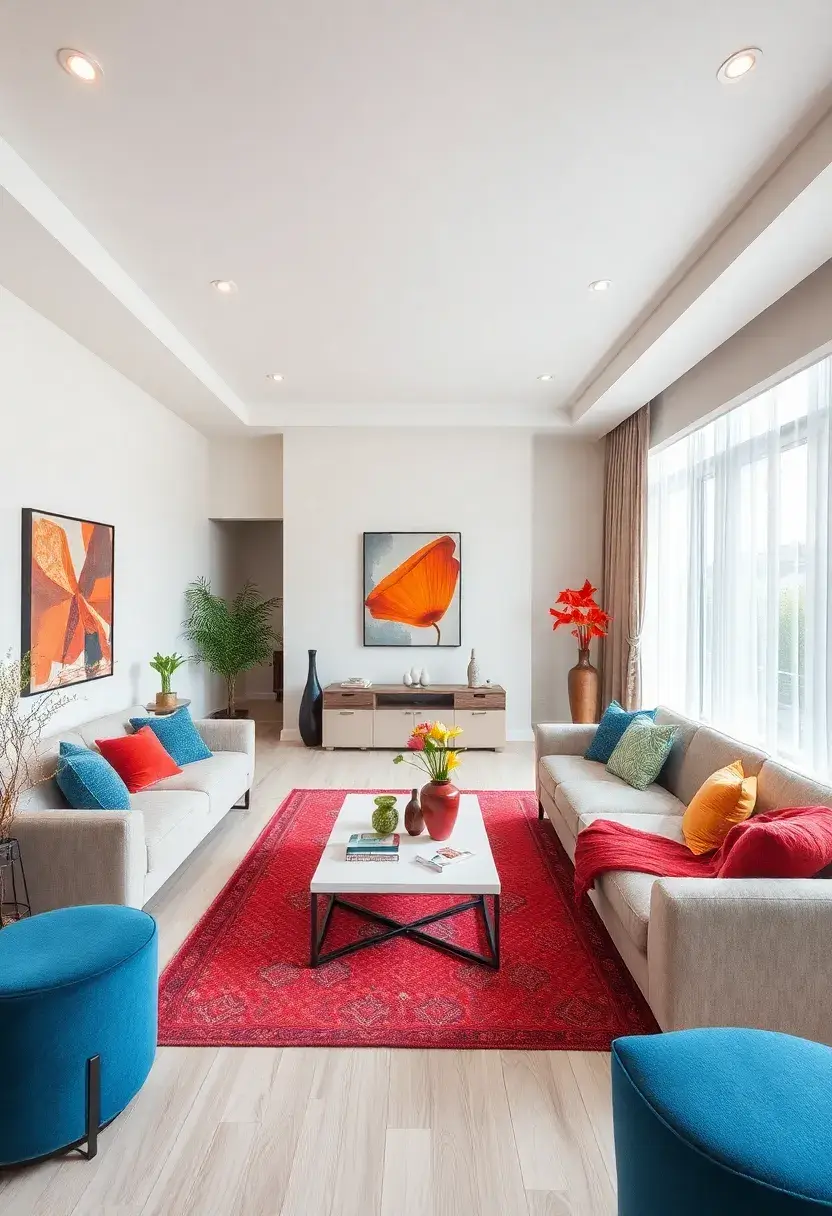
Using a neutral base in your long living room allows for flexibility with bold accents. Start with soft, muted colors for walls and large furniture to create a calm backdrop. This gives you the freedom to experiment with vibrant accessories, such as colorful cushions, artwork, or area rugs that can easily be changed out. This approach keeps your space feeling fresh while maintaining timeless elegance.
For practical tips, use monochromatic schemes for a sophisticated look. Incorporating texture prevents neutrality from feeling flat, adding depth and interest. Ensure that bold accents resonate with your style, tying the room together beautifully.
• Use monochromatic schemes for sophistication.
• Incorporate texture to add depth.
• Ensure bold accents resonate with your style.
• Keep a calm backdrop for flexibility.
These design ideas will help you create a long living room that feels both modern and inviting.
Neutral Base with Bold Accents
Editor’s Choice

Multicolored Rainbow Abstract Throw Pillow Covers 18×18 in Set of 2, Dec…
 Amazon$9.99
Amazon$9.99
SHACOS Soft Cozy Fluffy Arch Pattern High-Low Pile Textured Area Rug 5’3…
 Amazon$69.99
Amazon$69.99
uniro Vintage Wall Art Prints Farmhouse Decor Hummingbird Sketch Canvas …
 Amazon$6.99
Amazon$6.9928. Curated Textiles
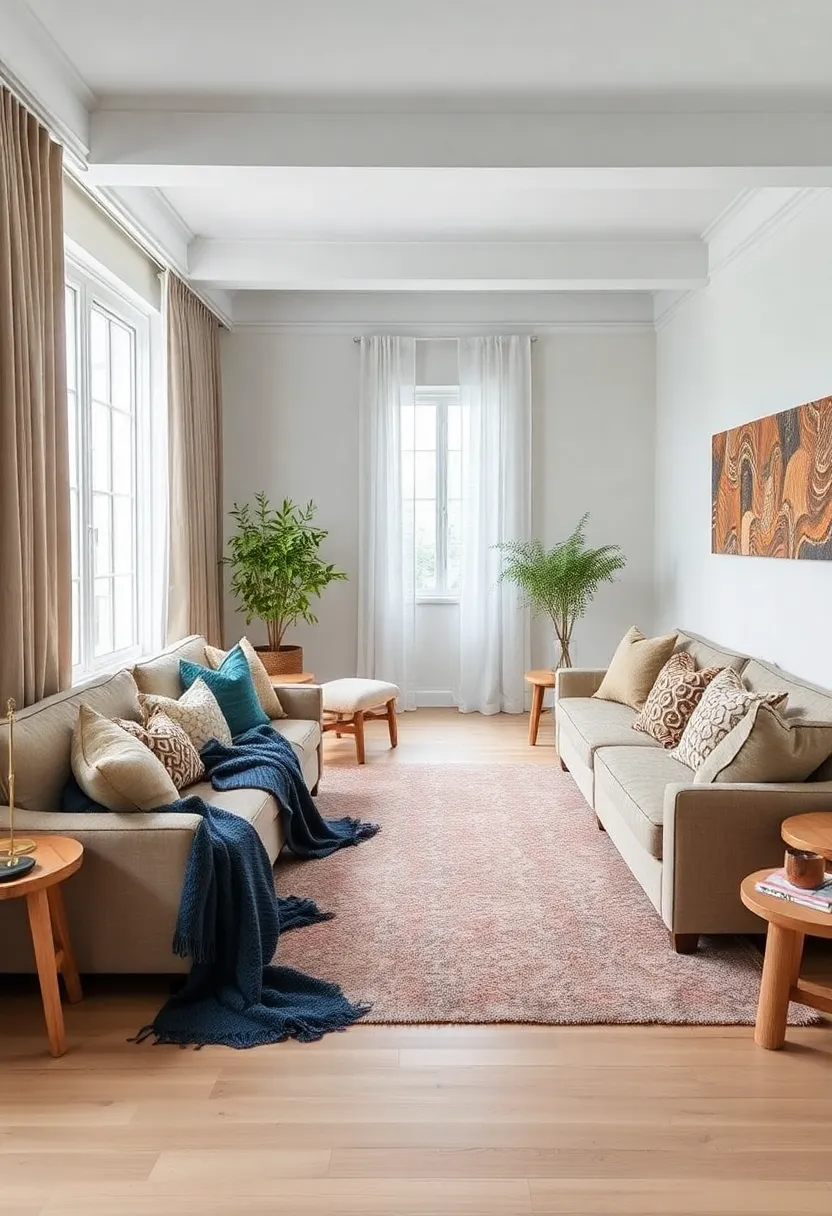
Curating textiles effectively can transform the ambiance of your long living room. Incorporate a variety of textiles, such as cotton, wool, and linen, to add depth and interest. Use throws, cushions, and curtains to create a warm, inviting feel while enhancing the overall decor. Choosing patterns and colors that complement your palette ensures a cohesive look.
For practical tips, layer different textiles for added warmth and comfort. Choosing seasonal textiles keeps the look fresh and adaptable throughout the year. Use textiles to introduce pops of color without permanent commitment, allowing for easy changes.
• Layer different textiles for warmth.
• Choose seasonal textiles for freshness.
• Use textiles to introduce pops of color.
• Ensure patterns complement your palette.
These curated textile ideas will help your long living room feel cozy and inviting.
Curated Textiles
Editor’s Choice

Bedsure Gentlesoft 100% Cotton Large Throw Blanket for Couch 50×70 inche…
 Amazon$24.99
Amazon$24.99
Utopia Bedding Throw Pillows (Set of 4, White), 18 x 18 Inches Pillows f…
 Amazon$23.64
Amazon$23.64
MIULEE Natural White Linen Curtains 84 Inch Long for Bedroom Living Room…
 Amazon$18.95
Amazon$18.9529. Mixing Old and New
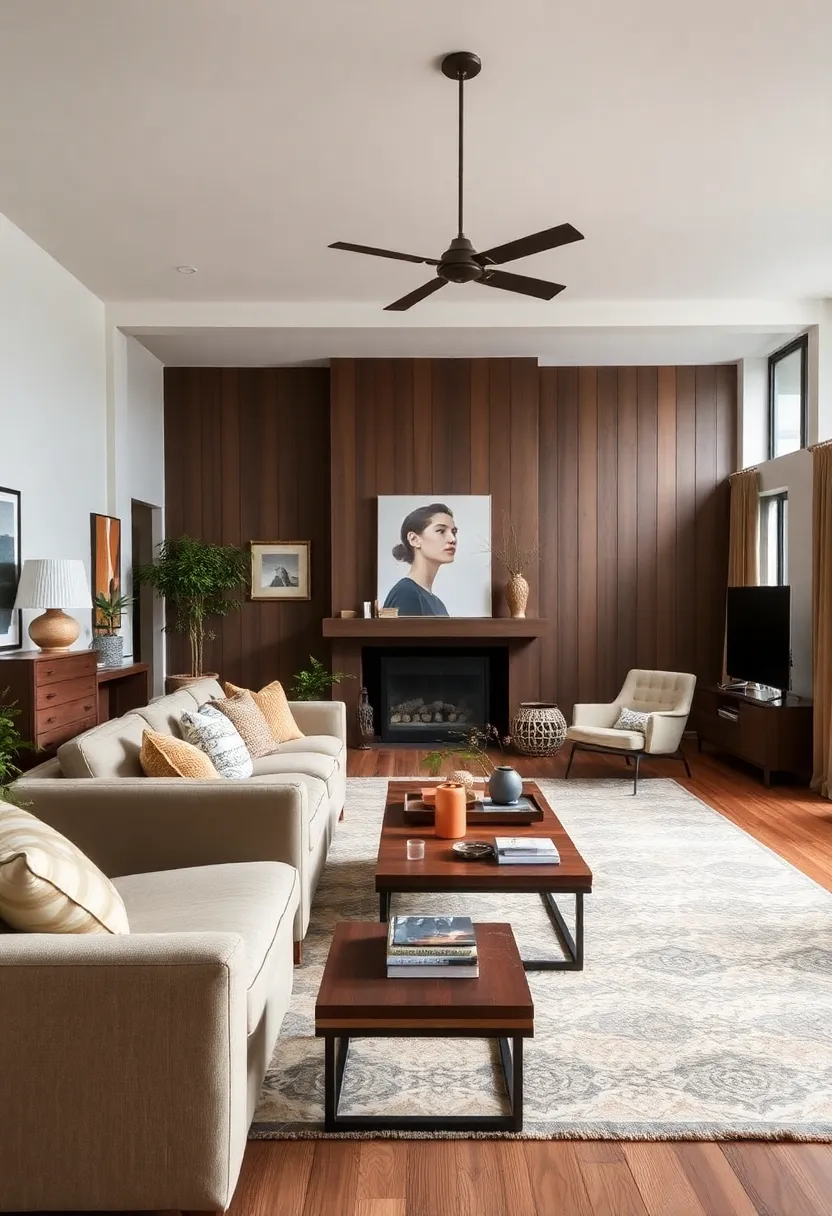
Blending old and new elements in your long living room creates a unique and balanced aesthetic. Incorporate heirloom pieces alongside modern furniture for a curated look that tells a story. Pay attention to how colors and styles interact, ensuring they complement each other rather than clash. This design choice celebrates the charm of vintage finds while embracing contemporary trends.
For practical tips, use modern accessories to highlight vintage pieces, creating contrast. Choosing a cohesive color palette can tie together different styles, making the space feel harmonious. Mixing large and small items adds balance and keeps the arrangement interesting.
• Use modern accessories to highlight vintage items.
• Choose a cohesive color palette for harmony.
• Mix large and small items for balance.
• Celebrate vintage charm alongside modern designs.
These mixing ideas will help you create a long living room that feels both timeless and fresh.
Mixing Old and New
Editor’s Choice

Blue and Grey Abstract Art Artwork Pillow Cover, Gallery Modern Decorati…
 Amazon$9.99
Amazon$9.99
VIYYIEA Framed Wall Art for Living Room, Swan Art Canvas Prints, Vintage…
 Amazon$15.99
Amazon$15.99
nuLOOM 4×6 Thigpen Contemporary Area Rug, Grey, Abstract Lines, Non-Slip…
 Amazon$20.83
Amazon$20.8330. Transformative Wall Treatments

Transforming your walls can significantly alter the look and feel of your long living room. Consider using removable wallpaper for an easy update that doesn’t require a long-term commitment. Painting an accent wall in a bold color or trying a fun pattern can break the monotony of a long space. Wall decals or stencils offer a creative way to add character without making permanent changes.
For practical tips, experiment with high contrast to make a statement, ensuring it draws attention. Using wall treatments strategically can create focal points that enhance the overall design. Combining different textures, like wood and paint, adds intrigue and depth to your decor.
• Experiment with high contrast for impact.
• Use wall treatments to create focal points.
• Combine textures like wood and paint.
• Consider removable wallpaper for flexibility.
These transformative wall treatment ideas will help you create a long living room that feels fresh and inviting.
Transformative Wall Treatments
Editor’s Choice

Art3d Smoothing Tool Kit for Applying Peel and Stick Wallpaper, Vinyl Ba…
 Amazon$5.99
Amazon$5.99
3D Wall Stickers DIY Flower Wall Decal Removable Waterproof Wall Art Dec…
 Amazon$12.98
Amazon$12.98
Rust-Oleum 1990502 Painter’s Touch Latex Paint, Quart, Flat White 32 Fl …
 Amazon$16.98
Amazon$16.98Conclusion

Designing a long living room doesn’t have to be a daunting task; with the right ideas, it can be a dream come true.
Each approach discussed promotes a natural flow while ensuring comfort and style.
Whether you lean towards cozy decor, space-saving solutions, or creative layouts, these suggestions are sure to inspire your design journey.
Note: We aim to provide accurate product links, but some may occasionally expire or become unavailable. If this happens, please search directly on Amazon for the product or a suitable alternative.
This post contains Amazon affiliate links, meaning we may earn a small commission if you purchase through our links, at no extra cost to you.
Frequently Asked Questions
What Are Some Creative Ideas for a Long Living Room Layout?
When it comes to a long living room layout, think outside the box! You can create distinct areas by using furniture arrangements that promote flow. Consider a U-shaped seating arrangement or a long sectional that encourages conversation. Adding rugs can help define zones within the space, making it feel cozier and inviting.
Don’t forget about incorporating space-saving furniture ideas, like ottomans with storage or wall-mounted shelves, to maximize your living room’s potential!
How Can I Maximize Natural Light in My Long Living Room?
Maximizing natural light in your long living room can transform the space! Use light-colored curtains or blinds that can be opened wide to let in sunlight. Mirrors are your best friend here; they can reflect light and make the room feel larger and brighter.
Consider placing furniture away from windows to avoid blocking light and using reflective surfaces in your decor. Plants can also soften the space while letting light shine through—so go green!
What Cozy Living Room Decor Ideas Work Best for Long Spaces?
Creating a cozy vibe in a long living room is all about the details! Layering textures with throw pillows, blankets, and rugs can add warmth. Use a mix of materials like wood, fabric, and metal to create visual interest.
Incorporate personal touches, like framed photos or artwork, along the walls. You can also add ambient lighting with floor or table lamps to create a welcoming glow in the evenings.
What Are Space-Saving Furniture Ideas for a Long Living Room?
Space-saving furniture ideas can work wonders in a long living room. Look for multifunctional pieces, like a coffee table that doubles as storage or a sofa bed for guests. Wall-mounted shelves can help free up floor space while displaying your favorite decor.
Consider nesting tables that can be tucked away or collapsible chairs for gatherings. These ideas not only save space but also keep your living room stylishly functional!
How Can I Create an Open Concept Living Room Feel in a Long Space?
To create an open concept living room feel in a long space, opt for a consistent color palette throughout the area. This creates a seamless flow, making the space feel larger. Use furniture arrangements that encourage movement, like a long sofa facing an open area.
Adding transitional decor elements, such as area rugs or lighting, can also help connect different sections while maintaining a cozy ambiance. Don’t shy away from large art pieces that can act as focal points!
Related Topics
home decor
small spaces
long living room
open concept
cozy decor
space-saving furniture
natural light
modern style
DIY ideas
beginner friendly
layout inspiration
design trends

